I Took a Train Across the U.S. and Here Are 12 Great and Awful Things About It
Yes, you can travel from coast to coast via Amtrak.
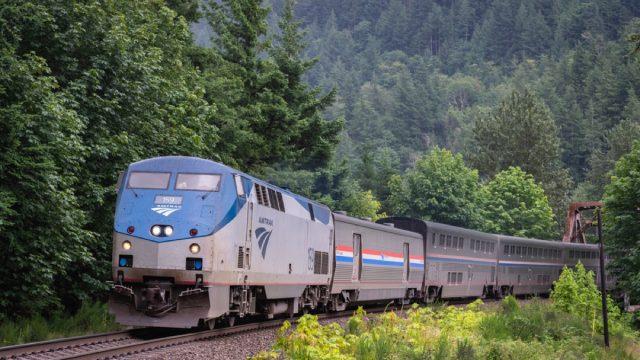
When I say I hate to travel, what I really mean is that I hate flying. I have no beef with travel in a broader sense; in fact, there's a lot I enjoy about spending time away from home, and I've found that the journey itself can be its own source of joy. That's especially true if you engage in one of the more drawn-out forms of travel, where the travel itself is part of the vacation: a cruise, a road trip, or, yes, a long train ride. In my case, that meant a cross-country train from New York to Los Angeles—and back again.
For my recent trip, I traveled on Amtrak's Lake Shore Limited from New York to Chicago, then took the California Zephyr from Chicago to Emeryville, California, in the San Francisco Bay Area. I stayed overnight, and took the Coast Starlight down to Los Angeles the next day. On the way back, I went with a more direct route: the Southwest Chief from LA to Chicago, and the Lake Shore Limited once again to New York.
My recent voyage was my second cross-country train ride (and third, if you count the return trip separately), so I feel like I'm something of an expert at this point. And that's a good thing, because when you tell people you're taking a train coast to coast, you get a lot of questions. With that in mind, I put together a list of the best and worst things about taking a cross-country train, inspired by the things people seem most curious to know. Read on for my breakdown of the pros and cons.
RELATED: The 6 Most Beautiful Train Trips You Can Take in the U.S.
1
It's one of the best and most unique ways to see the country.

You might consciously know how stunningly diverse the landscape of the U.S. is, but there's a difference between knowing it and seeing it. Moving from state to state and region to region gives you a unique look at how much variety there is—from cities to small towns, deserts to forests, and rivers to lakes to oceans. Flying 30,000 feet in the air doesn't give you perspective on much aside from clouds. When you're on the ground, and still moving at a faster pace than you could in a car, you can start your day with arid mesas and find yourself surrounded by trees in the afternoon.
As a bonus, lots of stops along the way are in smaller communities, and as you slow down, you get to see a wide variety of neighborhoods close to the station. These sights may not be as majestic as the Mississippi or Donner Pass, but they offer their own unique window into how people in different parts of the country live.
2
But you don't get to do much exploring.

If you're someone who wants to see and also explore the regions of the U.S., you may want to opt for a road trip instead. One of the questions people always ask me about taking the cross-country train is how much time you get to walk around the places you stop. With limited exceptions, the answer is not really any time at all. Most stops are just for people to get on and off the train, with "fresh air stops" every few hours. Even those generally just allow you five or 10 minutes to step out and stretch your legs, so not exactly enough time to see what the city has to offer.
Yes, you can book a cross-country train trip that involves multiple stops with stays in the locales of your choosing. For me, that's way too much stopping and starting. Compared to flying, train travel takes long enough as is—more on that below—so I wouldn't want to add multi-night hotel stints across the country to that. If that's more your speed, however, you can check out Amtrak Vacations, which offer curated travel plans with excursions included. I met a mother and daughter on the train who raved about it.
RELATED: 10 Scenic Road Trips That Will Make You Fall in Love with America.
3
You'll get amazing photos.
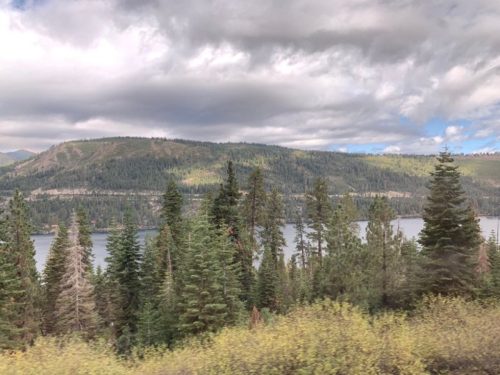
I took constant photos while I was on the train—I've included many of my favorites here—and scrolling through my phone after I got home offered some gorgeous reminders of all the places I'd been. It can be hard to get the right shot, but eventually you get the hang of snapping pics from a fast-moving train. (Keeping your phone level while the train is moving is a uniquely frustrating experience.)
Do be aware that train windows are not exactly sparkling clean, which can interfere with the perfect shot. Depending on the time of day, you might also have to deal with glare and your own reflection. To me, though, that's all part of the appeal of train photos: You're not just documenting the land you're passing through, but also the experience of seeing it from the train, blurry trees and all.
4
But there will be long stretches where there isn't much to see.
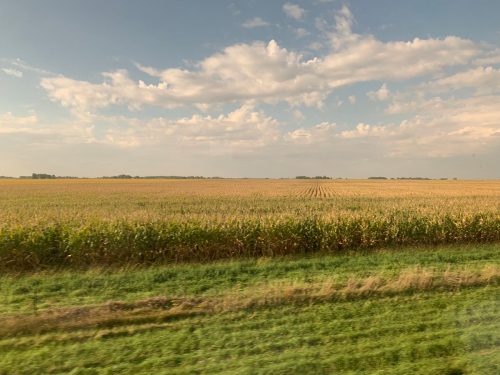
There will almost certainly be breathtaking sights on your journey, but depending on which route you take, there will also be countless hours where there just isn't a ton of variety. If you bring reading material or something to watch on your computer or iPad, this isn't really a problem—and I find that I still end up staring out the window, even if I am just looking at the 87th cornfield in a row. For those who are easily bored, however, long-distance train travel might be a challenge.
There are other, more frustrating impediments to seeing the sights. You could end up sitting on the wrong side of the train, as I was when I took the Coast Starlight down to LA. That meant that in order to enjoy the unbelievable views of the Pacific Ocean at sunset, I had to use the windows outside of my room. (I still had a great time, and took a staggering number of photos.) But no matter which side you're on, you won't be able to see a thing once it gets dark. And if you're traveling in the fall to see changing leaves, you'll find that happens much earlier than you'd like.
RELATED: 12 Small Towns in the U.S. That Feel Like Stepping Back in Time.
5
Car attendants will make your experience that much better.
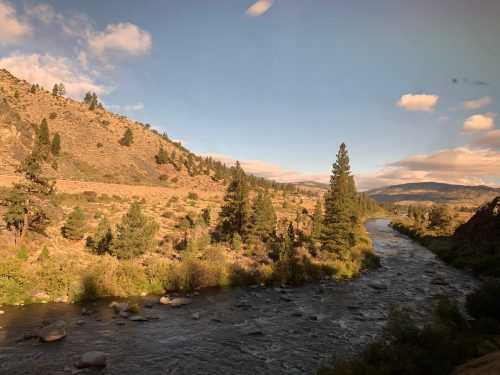
If you're in a sleeper car, you'll have an attendant who will be with you for the whole trip. Their job is to make you comfortable and get you anything you need. That means making up your bed at night and putting it away in the morning, along with answering any questions you might have and giving you advice on when to look out your window for the best scenery. If you're someone like me who prefers eating in your room to making a reservation for the dining car, your attendant will take your order and bring you your meals. Most car attendants also always have hot coffee ready whenever you want it—a true blessing.
I've had eight different attendants over the course of my cross-country train travels, and they've all been great, though some are much more attentive than others. You're paying for a luxury experience when you book a sleeper (see below), and the attendants are absolutely part of that. Just make sure you tip them well, especially when they go above and beyond.
6
But you'll pay a high price for a sleeper car.

There are a few different sleepers you can book, but unfortunately, they're all going to cost you. A roomette is the smallest and is basically two seats across from each other. Those seats convert into a bed and there's also a bed that comes down from the ceiling, so these rooms can fit two people—as long as you don't mind getting cozy. Some train roomettes have a toilet in the corner, though you might prefer using the shared bathroom in the train car.
A bedroom is twice as big as a roomette—this is what I've booked for the longer legs of my trips. (I find that a roomette is fine for the one-night journey between New York and Chicago, but I need more space for anything beyond that.) You get larger windows, a full sofa (that also converts to a bed) with additional seating, and a vanity. Most importantly, bedrooms have a bathroom with a shower, and as long as you're not expecting anything fancy, you'll be grateful for the privacy. Family bedrooms are even bigger, but don't have that bathroom, which does not feel fair.
Prepare yourself for some sticker shock once you start pricing out a trip in any sleeper car room. Depending on how long the trip is and how much space you feel like you need, you're looking at ticket prices from several hundred dollars to a few thousand. For me, it helps to remember that the train itself is part of the vacation, so it's something I don't mind saving up for the way I would any other trip. But if you want a bed to sleep in and a place to shower, the train is not an economical way to travel cross-country.
RELATED: How I Turned a Budget Cruise Into a Luxury Experience.
7
It's faster than you might think.

Anyone who has taken a cross-country road trip knows that it's not a quick journey—you're looking at about a week of travel, unless you're doing it in shifts and never stopping to rest overnight. (I really don't recommend that!) Trains don't have to stop for meals or to rest, however, and at their top speeds, they go much faster than cars.
My trip to LA was longer, because I took a less direct route: I left New York Saturday afternoon, got to Chicago on Sunday, arrived in Emeryville on Tuesday, and got to LA Wednesday night. On the way back, it was a straight shot: I left LA Thursday evening, reached Chicago Saturday afternoon (and had a seven-hour layover), and made it back to New York Sunday evening.
Basically, you're looking at three or four days of travel. It goes without saying that the trip takes considerably longer than flying. But it's still much less time than you'd think! Even knowing exactly how long the journey would take, I still found myself marveling at how much ground we'd covered in just a few days. And because these trains often leave in the afternoon or evening, you can easily complete the trip over a long weekend.
8
But be prepared for potential major delays and detours.
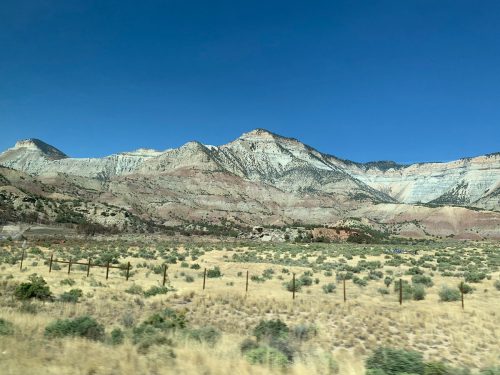
As with any form of travel, delays are unfortunately to be expected on trains. I had pretty good luck on that front during these last cross-country trips—most of my trains arrived on time, if not a bit early. Just like when you fly, there's always a little extra time baked in, so even if you appear to be running an hour behind, the train can generally catch up to its schedule by the time you reach your destination.
Be aware that certain times of year are worse: I had originally planned a winter trip before realizing how delayed those trains can get amid heavy snow. But the major cause of delays is freight train interference. As Amtrak notes, it shares the rails with freight trains—and sometimes they get precedence.
The major disappointment on my trip out west wasn't a delay, but a detour. I had booked the entire trip around the Colorado section of the California Zephyr route, which is widely regarded as one of the most beautiful this country has to offer. Then, a week before my departure, I got an email that track work would force me off the train and onto a bus from Denver to Grand Junction, Colorado. Given how much I'd been looking forward to this specific stretch of the journey, it was honestly a little devastating. And there wasn't anything I could do about it. The bus itself was totally fine and I still got some good pics driving through the Rockies (including the one above!), but I do feel like I missed out in a big way.
RELATED: 8 Best Natural Wonders Found in U.S. National Parks.
9
All your meals are included if you book a sleeper.
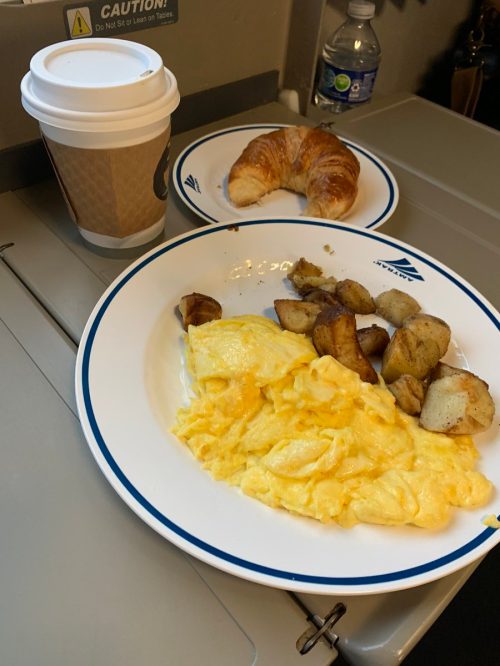
Aside from the question of how long the total trip takes, the other most frequently recurring question I get from train-curious folks is, "How is the food?" And the answer: pretty good, actually!
All your meals are included with the purchase of a sleeper ticket, which means you'll get breakfast, lunch, and dinner onboard. Dinner is a three-course meal, and you get an alcoholic beverage with that. (Or as much iced tea and Diet Coke as you want, if you're me.) And yes, most of what I ate was in the solid to very good range, with a few key exceptions (more on that below).
There's a lot of personal preference that comes into train dining. Most people seem to like eating in the dining car, because it's fancier. (You have to make a reservation, though rest assured, everyone who wants one in the sleeper car gets one.) For me, the real downside of the dining car is that parties of three people or fewer are usually sat with strangers. This is an advantage for many train passengers! For introverts, in-room dining is an easier option, and you still get all the same food (and none of the forced socializing).
10
But the food quality varies, and you might get bored.

Those three-course meals, or "traditional dining," are available on most routes, but I've discovered that east of Chicago you're stuck with "flexible dining," which is a very generous way of saying "microwave meals." They are… not great. It may depend on what you order, but my salmon (pictured above) had been microwaved beyond the point of recognition. I've had worse food while traveling—though not by much. Even by airplane food standards, this was rough.
And on trains with traditional dining, you might get a little tired of the options. I'm a pescatarian, so I'm already working off a more limited menu. That means repeating meals a few times over, in some cases. Ultimately that wasn't a huge deal for me, a creature of habit who can definitely eat the same lunch several days in a row. But by the end of my two cross-country trips, I was very ready to move on from train food. Even the good stuff had become a bit boring, and I was desperate for more options.
RELATED: 6 Airplane Meals You Should Never Eat, Experts Warn.
11
There's a real thrill to waking up in a new state every morning.

I wake up earlier on the train than I do at home, in large part because I leave the curtains open a little bit more than I should. But that's intentional: I like waking up with the sun and finding myself suddenly in a new state, with an entirely different landscape to see. Most of my days began with hot coffee, looking out the window, and then, yes, a respectable nap before lunch.
Long-distance train travel, not to mention a cross-country journey, is not for everyone. If you've read up to this point and find that the cons outweigh the pros for you, it's not something I'd try to talk you into. But I emphasize the thrill of it, because if you're able to give yourself over to the experience, there's really nothing else like it. While I'm very happy to be back home, I can't deny that I miss those quiet train mornings, and the sense of discovery as I opened Google Maps and saw how far we'd gone overnight.
12
But that's if you can fall asleep at all.
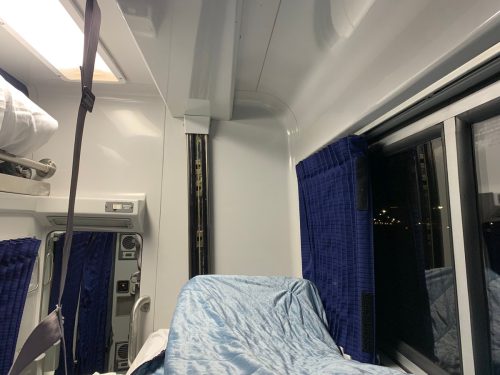
There's no question for me when I'm asked about the absolute worst thing about train travel: It's the sleeping. The beds are small and most are not terribly comfortable. And they shake. This is the part I can't emphasize enough. The movement of the train is intense. It is not the gentle rocking you probably associate with train travel. Overnight, the train goes fast, and if you're sleeping on the upper level, potentially in a bed suspended from the ceiling, you will be jostled violently and erratically, and you will need to get used to it.
I will say, I ended up sleeping better in that little bed hanging down from the ceiling in my roomette than in the bed converted from a couch in my bedroom. Maybe that's because I knew there was a net keeping me from falling down to the floor (a truly perilous drop), or because by the final leg of my return trip to New York, I was sufficiently sleep-deprived and could probably have passed out anywhere.
The fact of the matter is, trains are not ideal for sleeping, and gaining and losing hours overnight as you move between time zones just adds to the disorientation. For me, this is the only major downside of cross-country train travel—and it won't stop me from booking my next trip.
For more travel advice delivered straight to your inbox, sign up for our daily newsletter.





















